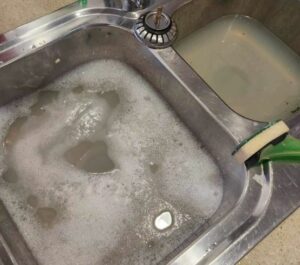How to Clean a Yoga Mat
-
 By
Sophia Grant
By
Sophia Grant

How often do you clean your yoga mat? Because it can easily become contaminated with unwanted residue.
For example, it can absorb the sweat, dirt, and oils from your feet and the floor.
Fortunately, there’s an easy fix. For example, you can use mild dish soap or yoga mat wipes to clean your dirty yoga mat.
How often should you deep clean your yoga mats? Can you use a homemade cleaning solution? For the answers, be sure to keep reading. We’ll be going over the answers below!
Table of Contents
ToggleImportance of Cleaning Your Yoga Mat Regularly
Your yoga mat can quickly turn into a breeding ground for bacteria and fungi if not cleaned regularly. According to the Centers for Disease Control, flu viruses can survive on a yoga mat surface for up to 24 hours while cold viruses last several days.

Beyond that, skin infection-causing fungi like Staphylococcus aureus could also thrive on the surface.
The good news is: that regular cleaning of your yoga mat will help keep these unwanted guests at bay. Remember, it isn’t just about cleanliness but also about health implications.
How Often to Clean Your Yoga Mat
Experts recommend cleaning after each use if you have had any history of skin infections or fungal issues.
But even if your medical chart reads cleaner than Cinderella’s floors, still aim to give your yoga mat a deep clean once every week.
Natural Cleaning Solutions for Your Yoga Mat
A natural cleaning solution can be an effective way to maintain the freshness and durability of your yoga mats. Here are some options.
Using White Vinegar
You can create your own cleaning solution using equal parts water and white vinegar.
Step 1: Create a Vinegar Solution

Mix equal parts of warm water and white vinegar in a spray bottle.
Step 2: Wipe the Mat

Apply a generous amount to a clean cloth and use it to wipe the surface of the yoga mat.
Step 3: Rinse the Mat

Rinse the cloth with water and use it to wipe the yoga mat again.
Supply:
- White vinegar
- Water
- Spray bottle
- Clean cloth
White vinegar will not only disinfect but will also help get rid of any odors.
Tea Tree Oil
If you want something stronger with additional antibacterial properties, consider adding tea tree oil into the equation.
Supplies:
- Tea tree oil
- Spray bottle
- Water
- White vinegar
- Clean cloth
Step 1:
Mix equal parts of white vinegar and water in a spray bottle, then add a few drops of tea tree oil.

Step 2:
Dampen a clean cloth with the vinegar mixture and use it to wipe the yoga mat.

Step 3:
Rinse the cloth with water, then use it to wipe the yoga mat again.

Different Methods to Clean Your Yoga Mat
Let’s dive into some ways you can get your closed-cell yoga mat clean. Remember, a well-maintained mat not only lasts longer but also helps in avoiding nasty skin infections.
Hand Washing Your Yoga Mat
The first method is hand washing, which you can do in a large tub.
Supplies:
- Dish detergent
- Microfiber towel
- Water

Step 1:
Fill a basin with lukewarm water and put in a few drops of dish detergent.

Step 2:
Dip your soft cloth or microfiber towel into the soapy water, then gently scrub both sides of the entire mat.

Step 3:
Rinse the yoga mat with cool water afterwards; there shouldn’t be any soap residue left on the surface.
Avoid using hot water as it can cause the yoga mat to warp.
Machine Washing Your Yoga Mat
You can machine wash your yoga mat as long as your washer is large enough
Supplies:
- ACTIVE Detergent
Step 1:
Carefully place the yoga mat inside the washing machine.

Step 2:
Add one scoop of ACTIVE Detergent and run a gentle cycle with cold water. Skip the bleach and fabric softener.

Step 3:
NEVER put your yoga mat in the dryer – let it air dry completely instead.

ACTIVE Laundry Detergent
Refresh your yoga mat and remove odors with our laundry detergent.

15% Off Your Order on Amazon
×Click below to reveal the 15% off coupon for your entire ACTIVE purchase on Amazon.com
Drying and Storing Your Yoga Mat
After a refreshing yoga session, you might be tempted to roll up your mat and stash it away immediately.
But that’s bad news for the longevity of your beloved mat. A damp mat is a breeding ground for bacteria, especially if rolled up tight right after use. So always let the entire surface of the yoga mat air dry first.
Let the mat dry completely before storing it – that’s key to prevent molding and mildew.
Don’t just leave it out on any flat surface though; an air-drying rack works wonders in maintaining its shape while allowing adequate airflow around it.
Taking Care Of New Mats: Breaking In & Storage Tips
New mats can feel slippery at first but don’t worry, there’s a simple fix – coarse salt scrubbing. Just like seasoning a cast iron pan makes food taste better, this method will improve grip by breaking down that slick factory layer.
To store your now-dry-and-grippy friend properly post-practice: roll loosely instead of folding (to avoid creases), and keep away from direct sunlight (it can cause discoloration) and extreme temperatures (they could warp its structure).
How to Clean a Yoga Mat – FAQs
What is the best way to clean a yoga mat?
Cleaning your yoga mat once a week with homemade natural solutions, like vinegar or tea tree oil, can keep it fresh and germ-free.
What can I use to clean my rubber yoga mat?
You can safely clean your rubber yoga mat using a mix of warm water and mild soap. Avoid harsh chemicals like bleach that might damage the material.
How do you clean a yoga mat naturally?
You can create an effective natural cleaner by combining equal parts white vinegar and water in a spray bottle. Add some drops of tea tree oil for extra antibacterial properties.
Can I use alcohol wipes to deep clean my yoga mat?
You sure can. Alcohol wipes are handy for quick cleaning after each session but remember they aren’t meant for deep cleaning which should be done regularly too.
SAVE
15% off
Your Next ACTIVE
Purchase on Amazon
15% Off Your Order on Amazon
×Click below to reveal the 15% off coupon for your entire ACTIVE purchase on Amazon.com
Limited Time Offer





